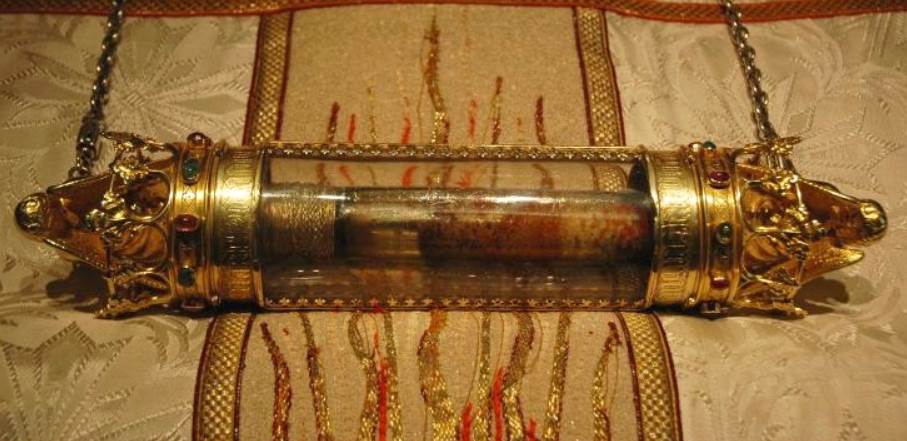The city of Bruges in Belgium is sometimes referred to as the “Venice of the North.” That’s mainly because of the extensive canals that flow through the medieval city center.
It was also a port city during the Middle Ages and one of the most important cities in Europe during this period. This resulted in one of the most important Christan relics being preserved here, the actual Blood of Christ.
Let’s take a closer look at some of the most interesting facts about the Basilica of the Holy Blood, the structure in which this remarkable relic is kept.
1. It’s located on one of the most important squares in the city
The Basilica of the Holy Blood is a Roman Catholic church and minor basilica in the city of Bruges in the northwestern part of Belgium. It’s located on one of the most famous squares in the city called “De Burg,” a word referencing its original use as a fortress in the heart of the city.
Some of the most important buildings in Bruges are located here, including the old residence of the Counts of Flanders which was transformed into the City Hall, the old Civil registry, and the Baroque Provostry of Saint Donatian.
This also means that this magnificent square is one of the oldest public spaces in the city of Bruges with multiple existing buildings dating back to the Golden Age of Bruges between the 12th and 15th centuries.
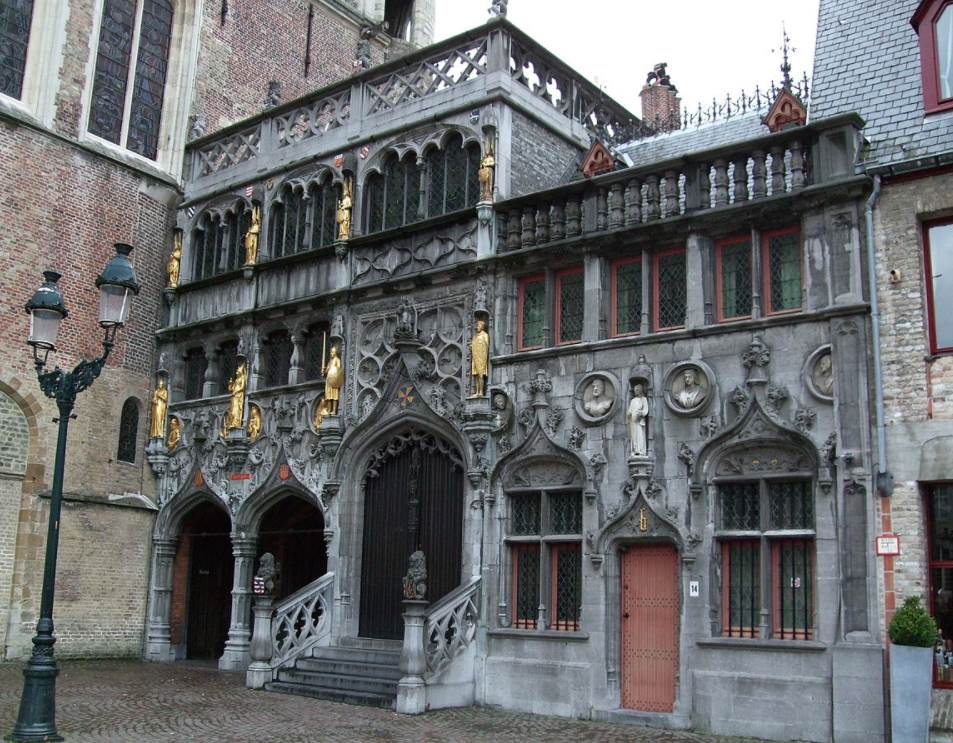
2. The lower chapel was completed in the 12th century
One of the most fascinating facts about the basilica of the Holy Blood in Bruges is that the lower chapel is still the original Romanesque structure that was completed between 1134 and 1157.
It was commissioned by the Count of Flanders at the time, a man named Thierry of Alsace (1099-1168), one of the most important men in Europe at the time.
He dedicated the church to Saint Basil the Great (330-379), a man considered to be holy in both Eastern and Western Christianity. Yes, this is the same saint to whom St. Basil’s Cathedral in Moscow was dedicated.
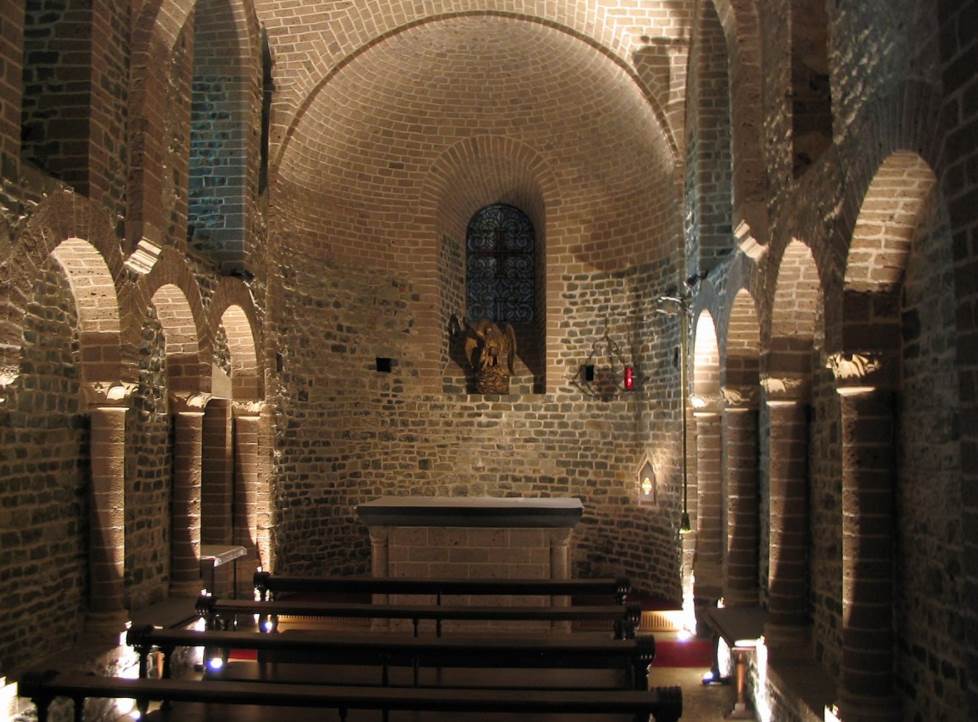
3. The upper chapel allegedly contains the actual blood of Jesus Christ
The church consists of both a lower chapel and an upper chapel. Only the lower chapel features the original 12th-century architecture, though.
The upper chapel was completely rebuilt in the Gothic and Renaissance architectural styles and was completed in the late 15th century. The monumental staircase leading up to the upper chapel is known as “De Steegheere” and was completed between 1529 and 1533.
If you want to get a glimpse of what is presumed to be the Holy Blood of Christ, then you’ll have to climb this staircase to the upper chapel as this is where this intriguing relic is kept.
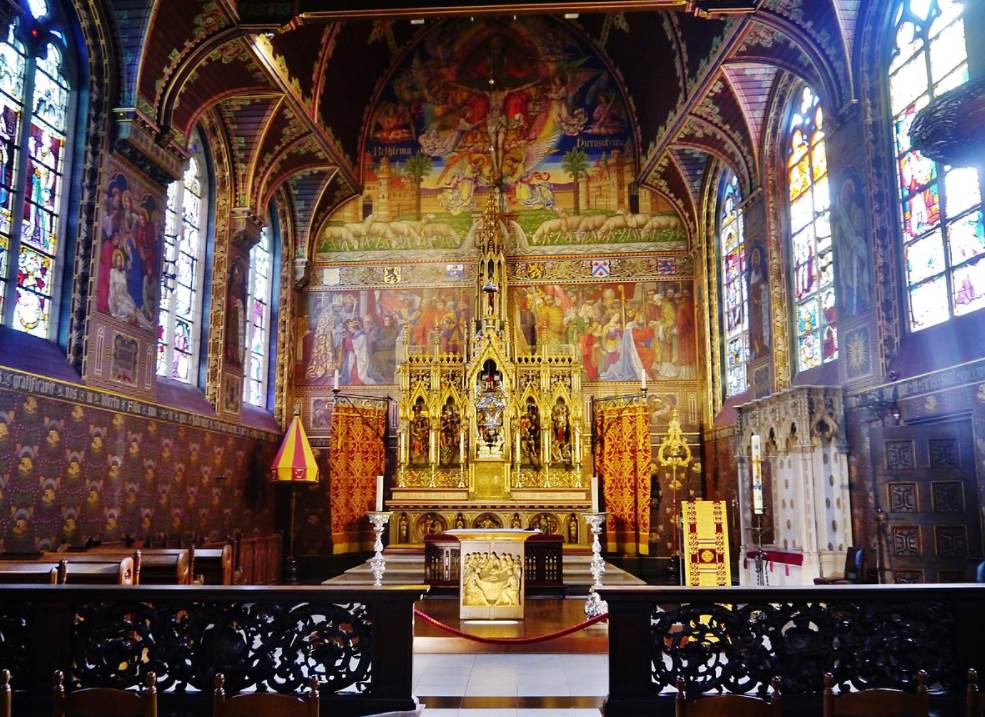
4. The Holy Blood was presumably brought to Bruges by the Count of Flanders
The man who commissioned the church, Thierry of Alsace, was the fifteenth Count of Flanders and was a man who was quite fond of invading southern territories. He actively participated in 4 campaigns in the Levant and Africa, including a prominent role in the Second Crusade (1147-1150).
It’s during this campaign that he was awarded the “Relic of the Precious Blood.” This is a bloodstained piece of cloth that was presumably collected by Joseph of Arimathea, the man who buried Jesus Christ following his crucifixion.
According to the legend, Thierry of Alsace arrived in Bruges on April 7, 1150, with the Holy Blood in hand and put the relic into his newly constructed church.
5. The blood is carried through the city once a year in a procession
If the story is true, then the Holy Blood can easily be described as one of the most important relics in Christianity.
The preserving of the actual blood of Christ is never mentioned in the Bible, however, but only in an apocryphal gospel known as the “Acts of Pilates.” This gospel provides an account of Joseph of Arimathea preserving the Blood of Jesus while he washed his dead body.
The relic has been treated as real by the Roman Catholic church since the Middle Ages. A yearly procession carries the relic around the city, a tradition that started way back in the late 13th century.
This procession with medieval roots takes place once a year in Bruges on Ascension Day, one of the best times of year to visit this fascinating city in Belgium.
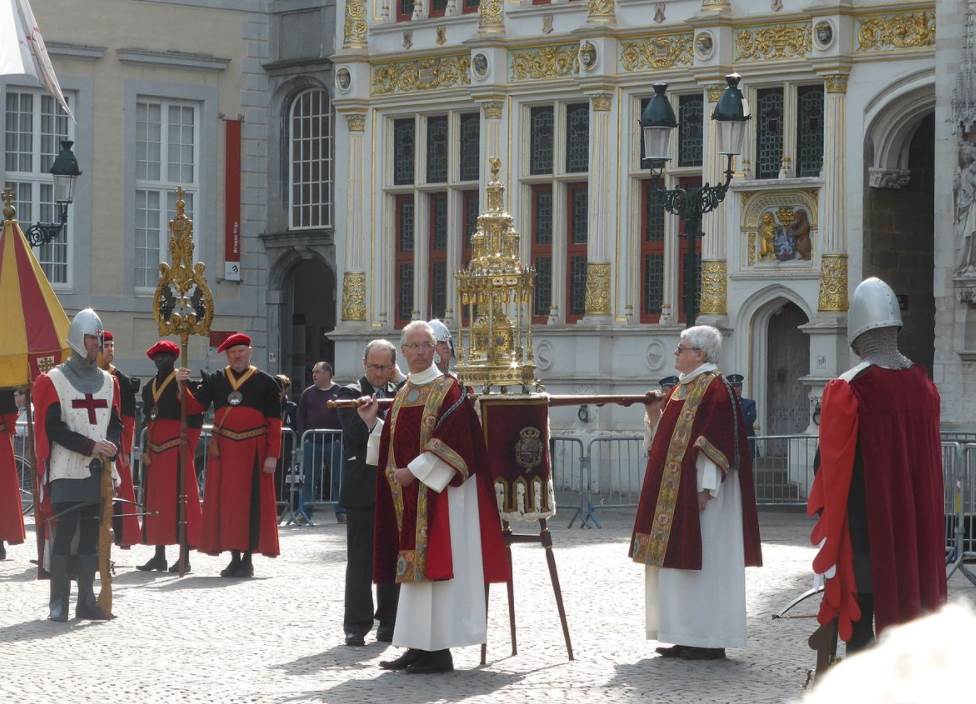
More interesting facts about the Basilica of the Holy Blood
6. The reason why the chapel was dedicated to Saint Basil is that the previous count of Flanders, Robert II (1065-1111), already brought back a relic dedicated to him to Bruges. He was one of the main figures of the First Crusade, earning him the nickname “Robert of Jerusalem.”
This also means that the Basilica of the Holy Blood wasn’t built for the Holy Blood itself, but this relic was brought back from Cappadocia, a region in southeastern Turkey.
7. The exterior of the basilica is decorated with gilded bronze statues and medallions. These statues represent Archduchess Isabelle of Burgundy, Mary of Burgundy, Thierry of Alsace, and Philip of Alsace.
The figures featured in the medallions represent Archdukes of Austria Albert VII and Maximilian III, Margaret of York, and Sibylla of Anjou. The latter was the wife of Thierry of Alsace.
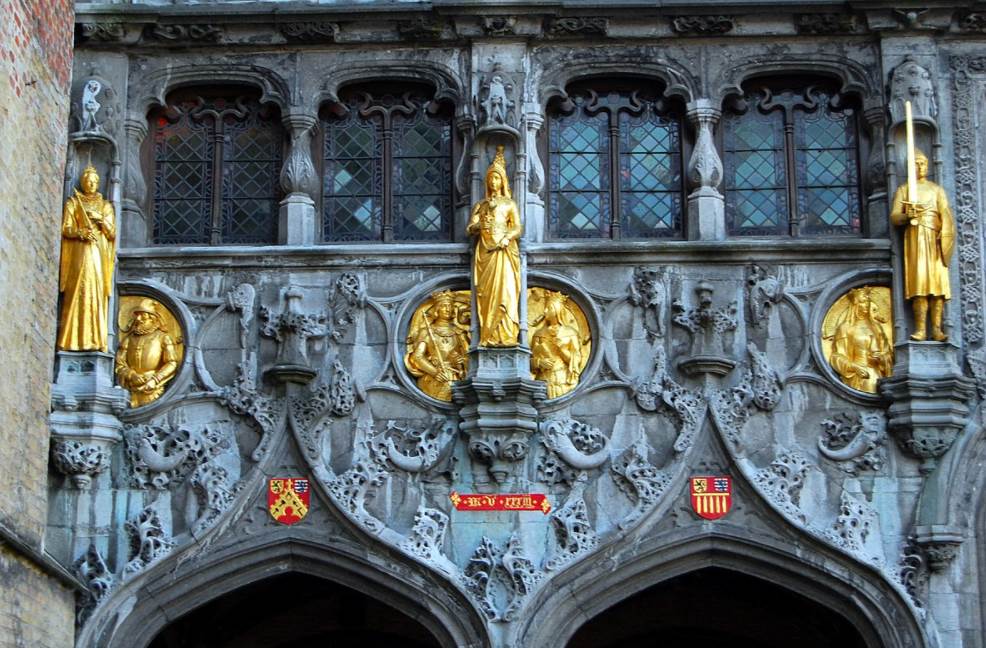
8. The Grand Staircase that leads up to the upper chapel was badly damaged during the French Revolution in the late 18th century. It was decided to rebuild it and slightly move it back, about 4 meters (13 feet), towards the “Oud Steen.”
This was one of the main renovation projects conducted during the 19th century that gave the upper chapel its Gothic Revival appearance.
9. The stained glass windows in the upper chapel were completed in the year 1845 and depict all the people who reigned over the county of Flanders.
This ranges from Philip the Bold in the 14th and 15th centuries to Archduchess Maria Theresa of Austria, Holy Roman Empress, in the 18th century.
10. Even though the upper chapel was completed in the 16th century, many additions to the interior were made much later. Some of these include a relief in alabaster depicting the Last Supper dating back to the 17th century and the pulpit in the form of a globe which was completed in 1728.
The painting decorating the wall behind the High Altar is called “The Mystery of the Cross.” It depicts both Bethlehem, the town where Jesus was born, and Jerusalem, the city where he died. This work of art was only completed in 1905.
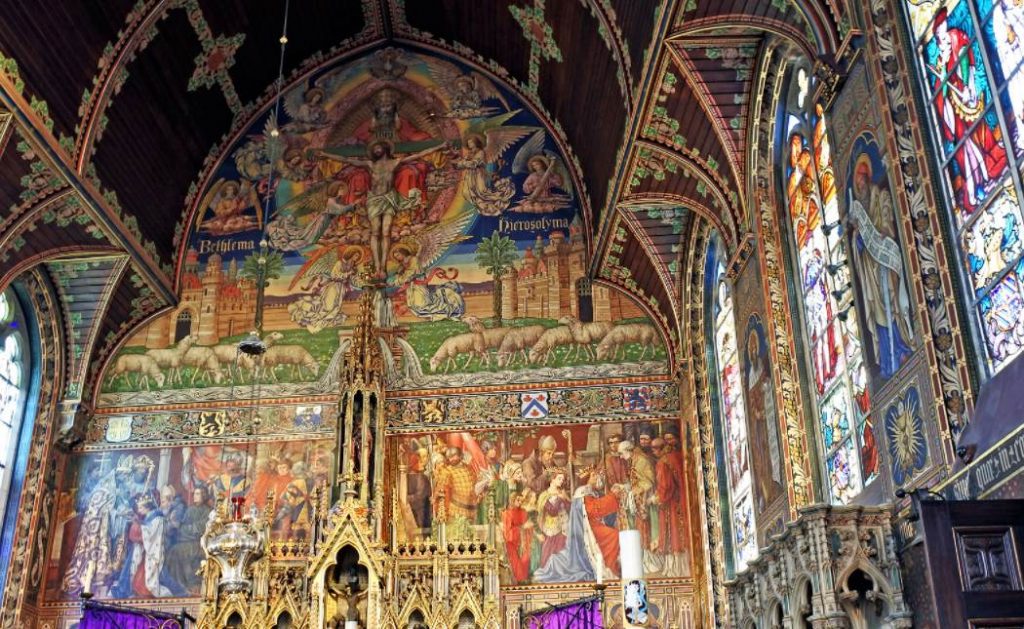
11. The Procession of the Holy Blood is quite a big event in Bruges as over 3,000 people from the city participate in it. The reliquary in which the Holy Blood is kept during the procession is quite extraordinary as well.
It was completed in the year 1617 and is made of gold and silver. It weighs over 30 kilos (66 lbs) and is decorated with about 100 precious stones as well.
12. So is the Holy Blood in Bruges the blood of Jesus Christ?
Recent research suggests that the relic wasn’t even present in Bruges when Thierry of Alsace returned from the Second Crusade in 1150. Evidence points toward the theory that the relic was brought to Bruges following the Sack of Constantinople (modern-day Istanbul in Turkey) in 1204.
The glass bottle in which the cloth with the presumed Holy Blood is kept has been identified as a Byzantine perfume bottle dating back to the 11th or 12th century.
This doesn’t reveal much which means that there is not a single shred of evidence both against or in favor of the relic being authentic, which means it will most probably remain a question with an open answer forever.
